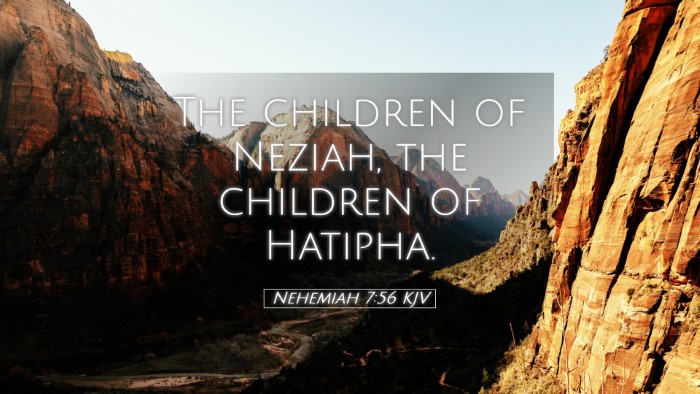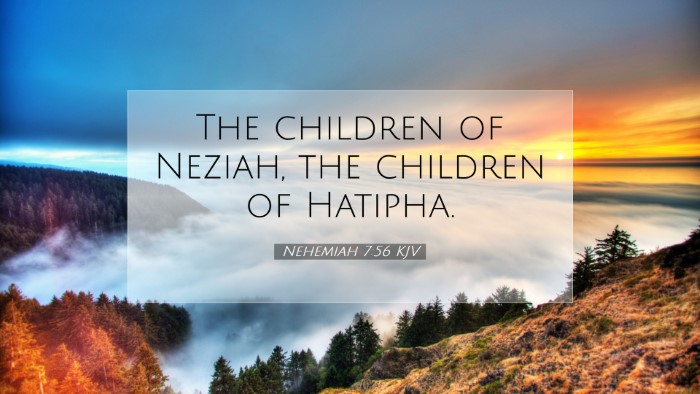Commentary on Nehemiah 7:56
Verse: Nehemiah 7:56 - "The Nethinim: the children ofZiha, the children of Hashupha, the children of Tabbaoth."
Introduction
The verse Nehemiah 7:56 sits within a chapter that lists the inhabitants of Jerusalem and the surrounding areas following the Babylonian exile. This chapter emphasizes the re-establishment of the community and their roles. The Nethinim, mentioned here, were a distinct class of temple servants, contributing significantly to the religious life of ancient Israel. Understanding the implications of their return provides insight into the overall mission of Nehemiah and the restoration of Israel.
Overview of the Nethinim
Definition and Role: The term "Nethinim" traditionally refers to those who were given or dedicated to the service of the house of God. They were often identified as temple servants, dedicated to various menial but necessary tasks that supported the Levitical priesthood and worship activities. Some commentators observe their role in light of the broader theme of restoration during Nehemiah’s time.
Insights from Public Domain Commentaries:
Matthew Henry
According to Matthew Henry, this listing of names exemplifies God's faithfulness to His people. The regathering of the Nethinim signifies not just a restoration of physical population but also a restoration of worship and service in the temple. He highlights that these individuals played a crucial part in maintaining the order and sanctity of worship, reflecting the commitment that the returning exiles had towards rebuilding their spiritual life and the community.
Albert Barnes
Albert Barnes notes that the genealogies in this chapter serve a dual purpose. Firstly, they reaffirm the validity of the restoration process by proving the continuity of Israel's heritage despite the exile. Secondly, he emphasizes that the Nethinim, along with the other groups mentioned, represent the diverse makeup of the community being restored. They were once captives and now are again part of the covenant community. The specific mention of the children of 'Ziha', 'Hashupha', and 'Tabbaoth' underlines the importance of having all segments of the community involved in the temple service.
Adam Clarke
In his remarks on Nehemiah, Adam Clarke focuses on the historical and practical implications of the return of the Nethinim. He stresses that their dedication to the temple was not merely a return to a physical location but a recommitment to the God of Israel. Clarke points to the way that this group, often overlooked in broader biblical narratives, serves as a reminder of the importance of every role in the community of faith—each person, regardless of status, contributes to the larger purpose of God’s work among His people.
Theological Reflections
The presence of the Nethinim signifies a theological affirmation of God’s enduring covenant with His people. This token of restoration demonstrates God’s intent to re-establish His worship in Jerusalem, promising that worship would resume with vigor and zeal. The mention of individual family lines among the Nethinim reinforces the idea that each person has a unique contribution to collective worship and community life.
Applications for Today
- Significance of Service: Like the Nethinim, every believer has a part to play in the body of Christ. The church thrives when everyone acknowledges their unique roles in supporting the ministry and serving one another.
- Inclusion in God’s Covenant: The return of the Nethinim reminds us that God’s grace extends to all, irrespective of their past. It is a powerful narrative against exclusion, echoing the New Testament message that all are welcome to the family of God.
- Generational Faithfulness: The identities of the Nethinim are connected to their fathers, highlighting the importance of teaching and passing down faith across generations. Ministries should focus on families and fostering intergenerational relationships.
Conclusion
Nehemiah 7:56 serves as more than a simple listing of names; it encapsulates themes of service, restoration, and the ongoing identity of God’s people. The Nethinim, though regarded as lower in the socio-religious hierarchy, proved indispensable to the restoration of the community’s worship practices. Through their example, the contemporary church is invited to recognize the value of every member, affirming the integral part we all play in God’s mission in our world today.


